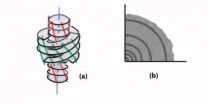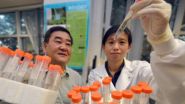(Press-News.org) Whatever the origin and condition of extraction of type I collagen fibrils, in vitro as well as in vivo, the radii of their circular circular cross sections stay distributed in a range going from 50 to 100 nm for the most part of them. Jean Charvolin and Jean-Francois Sadoc from the solid state physique laboratory at the Paris-Sud University propose therefore that, once the growth of the fibrils has been triggered by external biological factors, their lateral size be limited by internal physical stresses generated during the growth. Their conjecture is based on the remark that the assembly of the long triple helices building a fibril is a place of conflict between two incompatible requirements: (1) a double-twist around the fibril axis induced by the chirality of those molecules, and (2) a periodic layering normal to the fibril axis associated with their Hodge-Petrushka staggering.
If the initial planar configuration of the layering is kept unchanged as the growth proceeds, the stresses associated with this incompatibility increase and limit this growth rapidly. But if this configuration can switch to a helicoidal ones this increase can be limited and the growth pursued. However such changes require that the triple helices can slide along each other, i.e. their lateral cohesion must be weakened at the cylindrical surfaces along which the changes occurs.
The opportunity for this is contained in a recent model using the algorithm of phyllotaxis to build a dense organization of triple helices in fibrils with circular symmetry (see J. Charvolin and J.-F. Sadoc (2013), Biophysical Reviews and Letters, 8, 33-49 (2013). This organization shows indeed a succession of large rings or grains, in which each triple helices has six first neighbors and the cohesion is at its highest, separated by narrow rings of defects or grain boundaries in which this number is no longer maintained and the cohesion lowered.
Those grain boundaries can therefore be extended all along the cylindrical surfaces on which the configuration of the layering should change. However, as their radii follow the Fibonacci series, they are more and more spaced out when moving away from the center of the phyllotactic pattern: (1) they stay sufficiently close to each other not too far from the center so that the stresses can be relaxed before they become too important to prevent the growth, (2) they become too distant far from the center so that the stresses cannot be relaxed before they become sufficiently important and limit the growth.
The radius in the vicinity of which one situation changes to the other and the size limitation occurs compares well with those observed. The distribution of the grain boundaries in the phyllotactic pattern might therefore be determinant for the control of the lateral growth of type I collagen fibrils.
This conjecture relies upon a geometrical analysis of the structural distortions imposed by the very nature of the triple helices building the fibrils of type I collagen. Although crude at this level of development, the agreement obtained calls for an extension to similar systems of fibrils built by molecules different from the triple helices, as displayed by the wide variety of collagenic structures. Beyond its eventual interest for the conception of artificial tissues, such a program should also contribute to the most sensitive issue of the respective roles of genetics and physical chemistry in the building of morphologies needed for biological materials to fill their functions.
INFORMATION:
The study can be found in the upcoming issue of Biophysical Reviews and Letters. The full paper can be read at the following link, http://www.worldscientific.com/doi/pdf/10.1142/S1793048014500027.
Conjecture on the lateral growth of Type I collagen fibrils
2014-09-12
ELSE PRESS RELEASES FROM THIS DATE:
Extension of standard model by knot algebra
2014-09-12
This paper makes a connection between the quantum group SLq(2), which described knots, and the elementary particles of the standard model. The elements of the fundamental (j = 1/2) representation of SLq(2) are interpreted as creation operators for preons. The preons interact through a preonic vector field defined by elements of the adjoint (j = 1) representation. The leptons and quarks then appear (as required by the electroweak data) as elements of the j = 3/2 representation. Unexpectedly the electroweak quantum numbers of the so defined preons, leptons, and quarks agree ...
Scientists show that nicotine withdrawal reduces response to rewards across species
2014-09-12
Cigarette smoking is a leading cause of preventable death worldwide and is associated with approximately 440,000 deaths in the United States each year, according to the U.S. Centers for Disease Control and Prevention, but nearly 20 percent of the U.S. population continues to smoke cigarettes. While more than half of U.S. smokers try to quit every year, less than 10 percent are able to remain smoke-free, and relapse commonly occurs within 48 hours of smoking cessation. Learning about withdrawal and difficulty of quitting can lead to more effective treatments to help smokers ...
Favoritism linked to drug use in 'disengaged' families
2014-09-12
Before you revive the debate about which sibling in your family is the favorite, you'll want to know what the latest research shows.
Brigham Young University professor Alex Jensen analyzed 282 families with teenage siblings for a study that appears in the Journal of Family Psychology. Favoritism in parenting is a complex topic for sure, but here are some important take-aways.
Does it really matter?
Yes, at least for some families. Jensen looked at perceived preferential treatment in different types of family dynamics. For families that aren't very close to each other ...
Brain inflammation dramatically disrupts memory retrieval networks, UCI study finds
2014-09-12
Irvine, Calif., Sept. 10, 2014 — Brain inflammation can rapidly disrupt our ability to retrieve complex memories of similar but distinct experiences, according to UC Irvine neuroscientists Jennifer Czerniawski and John Guzowski.
Their study – which appears today in the Journal of Neuroscience – specifically identifies how immune system signaling molecules, called cytokines, impair communication among neurons in the hippocampus, an area of the brain critical for discrimination memory. The findings offer insight into why cognitive deficits occurs in people undergoing chemotherapy ...
No innocent bystander: Cartilage contributes to arthritis
2014-09-12
Melbourne researchers have discovered that cartilage plays an active role in the destruction and remodelling of joints seen in rheumatoid arthritis, rather than being an 'innocent bystander' as previously thought.
Dr Tommy Liu, Professor Ian Wicks, Dr Kate Lawler, Dr Ben Croker and colleagues from the Walter and Eliza Hall Institute made the discovery while investigating the role of the protein SOCS3 in controlling inflammation during rheumatoid arthritis. The study was published in the journal Arthritis and Rheumatology.
Rheumatoid arthritis affects more than 400,000 ...
A meta-analysis of 3 types of peer norms and their relation with adolescent sexual behavior
2014-09-12
Researchers at Utrecht University and the New York State Psychiatric Institute collaborated on a meta-analysis of research on adolescent sexual behavior. The goal was to analyze how this behavior is related to adolescents' perceptions of three types of sexual peer norms, including how sexually active their peers are, how much their peers would approve of being sexually active, or how much they feel pressured by their peers to have sex. Awareness that these are different ways in which peers can affect adolescents' sexual behaviors is important for parents, teachers, and ...
Protein appears to protect against bone loss in arthritis
2014-09-12
AUGUSTA, Ga. – A small protein named GILZ appears to protect against the bone loss that often accompanies arthritis and its treatment, researchers report.
Arthritis as well as aging prompt the body to make more fat than bone, and the researchers have previously shown GILZ can restore a more youthful, healthy mix. It also tamps down inflammation, a major factor in arthritis.
Now they have early evidence that GILZ might one day be a better treatment option for arthritis patients than widely used synthetic glucocorticoids, which actually increase bone loss, said Dr. Xingming ...
Dendritic cells affect onset and progress of psoriasis
2014-09-12
Different types of dendritic cells in human skin have assorted functions in the early and more advanced stages of psoriasis report researchers in the journal EMBO Molecular Medicine. The scientists suggest that new strategies to regulate the composition of dendritic cells in psoriatic skin lesions might represent an approach for the future treatment of the disease.
"We urgently need new ways to treat psoriasis, treatments that will deliver improved benefits to patients and reduce the incidence of known side effects for existing drugs," says EMBO Member Maria Sibilia, ...
Gray matter matters when measuring our tolerance of risk
2014-09-12
There is a link between our brain structure and our tolerance of risk, new research suggests.
Dr Agnieszka Tymula, an economist at the University of Sydney, is one of the lead authors of a new study that identifies what might be considered the first stable 'biomarker' for financial risk-attitudes.
Using a whole-brain analysis, Dr Tymula and international collaborators found that the grey matter volume of a region in the right posterior parietal cortex was significantly predictive of individual risk attitudes. Men and women with higher grey matter volume in this region ...
Age and diabetes duration linked to risk of death and macrovascular complications
2014-09-12
New research published in Diabetologia (the journal of the European Association for the Study of Diabetes) shows that age (or age at diagnosis) and duration of diabetes disease are linked to the risk of death and marcovascular complications (those in larger blood vessels), whereas only diabetes duration is linked to the risk of microvascular complications (in smaller blood vessels such as those in the eyes). This means younger people with diabetes are more at risk of microvascular complications since they are more likely to have diabetes for longer over their lifetimes ...




